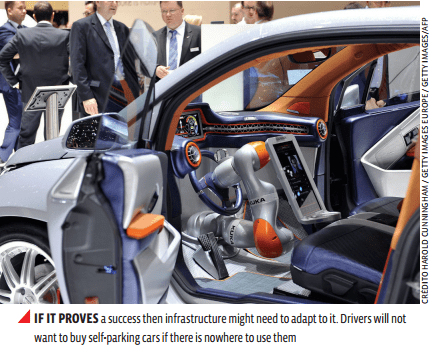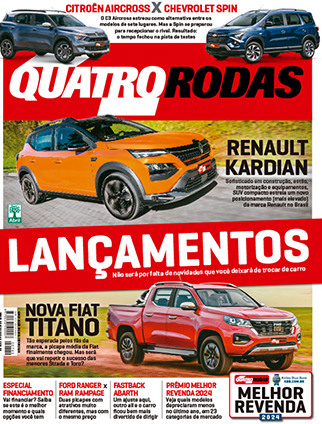Inglês: Interpretação – Driverless automobiles
The car that parks itself
Slowly and steadily the autonomous car will arrive, through an increasing number of automated driving aids. A Swedish carmaker has recently demonstrated one such feature

Cars that need no driver are just around the corner according to researchers who have been testing vehicles bristling with aerials and cameras on public roads in America. However, researchers do not make cars, so it will be up to firms that do to bring the technology to market. And carmakers are a conservative bunch. Still, slowly and steadily the autonomous car will arrive, with the help of an increasing number of automated driving aids. A Swedish carmaker has recently demonstrated one such feature: a car that really does park itself.
Some cars already have systems that assist with parking, but these are not completely autonomous. They can identify an empty parallel-parking space and steer into it while the driver uses the brake. The Swedish system, however, lets the driver get out and use a smartphone application to instruct the vehicle to park. The car then 1trundles off, manoeuvres into a parking place and sends a message to the driver to inform him where it is. The driver can collect the car in person or use his phone to call it back to where he dropped it off. Autonomous parking could thus be provided at places like shopping centers and airports, which are controlled areas in which automated vehicles can be managed more easily than on open highways. In the past, designs for doing this have relied on car parks being fitted with buried guide wires that a vehicle can follow to an empty bay. That, though, creates 2a chicken-and-egg problem: car-park operators will not invest in such infrastructure until there is a sufficient number of suitably equipped cars on the road. Drivers, conversely, will not want to buy self-parking cars if there is nowhere to use them.
This means, as a safety engineer working on the project observes, that for autonomous parking to work most of the technology will have to be in the car itself. The test car, which looks like a normal car, therefore uses on-board GPS mapping, cameras with imagerecognition software, and radar sensors to find its own way around a car park and avoid pedestrians and non-autonomous vehicles. The same engineer says the system is five to ten years from commercial deployment. If it proves a success then infrastructure might adapt to it, for instance by packing cars into tighter spaces. If there is no one in them there is no need to make room for their doors to open.
Driverless cars would also need to communicate with one another, to enhance safety. That, too, is coming. 3A number of carmakers are developing wireless networking systems through which vehicles can exchange data, such as their speed, their steering angle and even their weight, to forewarn anti-collision systems and safety devices if an accident looks likely.
In the USA, for example, a carmaker recently tested a brake light that can provide an early warning to other motorists. If the brakes are applied hard in an emergency, a signal is broadcast. This illuminates a warning light in the dashboard of suitably equipped following vehicles, even if they are out of sight around a bend or not immediately behind the vehicle doing the braking.
The American company has been testing this system as part of a collaborative research project with several European carmakers. 4They have put a fleet of 150 experimental vehicles on the roads. When they tested a group of these, the Americans found the technology let drivers brake much earlier, helping avoid collisions. A driverless car would be able to react even faster.
Another member of the research group has been testing driverless cars on roads around Munich— including belting down some of Germany’s high-speed autobahns. 5The ordinary-looking models use a variety of self-contained guidance systems. These include cameras mounted on the upper windscreen, which can identify road markings, signs and various obstacles likely to be encountered on roads.
The German cars also use a radar, to gauge how far the vehicle is from other cars and potential obstacles, and a LIDAR, which works like a radar but at optical frequencies. The LIDAR employs laser beams to scan the road ahead and builds up from the reflections a three-dimensional image of what this looks like. The image is processed by a computer in the vehicle, which also collects and compares data from a high-accuracy GPS unit. A series of ultrasonic sonars similar to those used in vehicles to provide parking assistance are placed around the car to add to the virtual picture. And just to make sure, a set of accelerometers provide an inertial navigation system that double-checks the vehicle’s position on the road.
6Although these cars can be switched to an autonomous driving mode, they are still required to have someone in the driving seat who can take over in the event of any difficulty. Some cars can steer themselves, slow down, brake and accelerate, even changing lanes to overtake slower vehicles.
From the print edition: Science and Technology Jun 29th 2013
EXERCÍCIOS – PUCRJ 2014 (adaptado)
Aponte a alternativa correta. Os números pequenos no texto principal são referências para a sua orientação.
1. The word “Although” (ref. 6) introduces
a) an additional idea.
b) an opposing idea.
c) a conclusion.
d) an example.
e) a chronological order.
2. The text implies that driverless cars are
a) the automobiles parked just around the corner.
b) a near future reality waiting to be adopted.
c) the Swedish vehicles used in conservative resorts.
d) the kind of transport developed for human hands.
e) the ones covered with bunches of stiff bristles.
3. The main idea of the article is
a) to applaud the new driverless car technology.
b) to argue that researchers should make cars.
c) to analyze the characteristics of European cars.
d) to prove that autonomous cars are too slow.
e) to highlight that Swedish carmakers are against new inventions.
4. According to a safety engineer working on the project, for autonomous parking to work, most of the technology involved has to be in the car itself. One device which is NOT present in the Swedish test car is
a) a radar.
b) a camera.
c) a lidar system.
d) a GPS mapping.
e) a smartphone application.
5. In the German testing car, the most distinctive characteristic, in comparison to the American project, is
a) the fact that it has a camera that identifies road markings.
b) the fact that it can be driven in high-speed roads.
c) the fact that it contains guidance systems.
d) the fact that it can be driven with “no hands”.
e) the fact that it is equipped with a brake light that warns other motorists.
6. The author uses the phrasal verb “trundles off” (ref. 1) that could be replaced by
a) rolls fast.
b) stops rolling.
c) rolls slowly.
d) does not roll.
e) does not start.
RESPOSTAS
1. Nesta questão, a banca pediu ao candidato que demonstrasse conhecimento sobre marcadores discursivos. Eles estabelecem uma relação de contraste, de oposição na sentença. A tradução para “although” é “embora”. A ideia de oposição está no fato de que embora esses carros possam funcionar automaticamente, ainda é necessário a presença de uma pessoa que venha assumir a direção numa eventualidade. Resposta: b
2. A pergunta pode confundir o estudante por causa do termo “imply”, que tem a melhor tradução no verbo “sugerir”. Como a tese do texto é de que carros sem motoristas serão realidade num futuro próximo, as alternativas equivocadas são as que sugerem: (a) os automóveis estacionados virando a esquina; (c) são os veículos suecos utilizados em resorts conservadores; (d) são um tipo de transporte desenvolvido para mãos humanas; (e) são aqueles cobertos com um punhado de cerdas duras. Resposta: b
3. Sabe-se pela leitura que o autor enaltece toda tecnologia contida nos automóveis e as benesses advindas disso, como: maior conforto, maior dirigibilidade e autonomia. Assim sendo, os verbos que condizem com o autor seriam positivos como “to applaud”. As demais não respondem ao que se perguntou, pois suas traduções contradizem a tese. Veja: (b) argumentar que pesquisadores devessem fabricar carros; (c) analisar as características do carro europeu; (d) provar que os carros autônomos são muito lentos; (e) salientar que fabricantes suecos são contra novas invenções. Resposta: a
4. Tipo de questão para testar a atenção aos detalhes do texto e compreendê-los. O único dispositivo que não está presente no carro de teste sueco é o sistema LIDAR – essa tecnologia está contida somente no protótipo alemão. Comprova-se isso com o trecho: “The German cars also use a radar, to gauge how far the vehicle is from other cars and potential obstacles, and a LIDAR, which works like a radar but at optical frequencies”. Resposta: c
5. A principal comparação feita entre os automóveis americanos e os alemães está relacionada ao fato de que, no protótipo alemão, câmeras instaladas identifcam marcas nas estradas, ao passo que os carros americanos possuem toda tecnologia de navegação, mas não essa. A resposta está no trecho: “These include cameras mounted on the upper windscreen, which can identify road markings, signs and various obstacles likely to be encountered on roads”. Resposta: a
6. Uma questão exigente, pois “phrasal verbs” muitas vezes são uma pedra no sapato dos estudantes. Há um número grande deles para estudar, mas nem sempre é possível aprender todos para o exame. Neste caso é bom saber que “trundle off” é mover-se vagarosamente. No entanto, se o estudante usar o seu conhecimento da realidade, poderá se apoiar no fato de que estacionar é um movimento lento quase sempre. Assim sendo, pode eliminar “mover-se rapidamente” (a); “parar de mover-se” (b), “não se move” (d) e “não dá a partida” (e). Resposta: c








